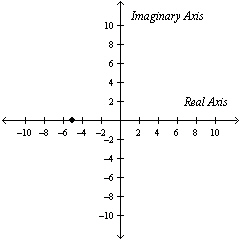|
|
|
1.
|
Perform the addition or subtraction and write the
result in standard form.

a. |  | b. | 4 | c. | 6 | d. | 5 | e. |  |
|
|
|
2.
|
Write the complex number in standard
form.

|
|
|
3.
|
Find a polynomial function with real coefficients
that has the given zeros.

|
|
|
4.
|
Find all zeros of the function  . .
|
|
|
5.
|
Given  is a root, determine
all other roots of is a root, determine
all other roots of  . .
|
|
|
6.
|
Given that  is a zero of is a zero of
 , find all the zeros
of f. , find all the zeros
of f.
|
|
|
7.
|
Write the complex
number in trigonometric form.

|
|
|
8.
|
Represent the complex
number graphically, and find the trigonometric form of the number.

|
|
|
9.
|
Find the standard form
of the complex number. Then represent the complex number graphically.

|
|
|
10.
|
Use a graphing utility
to represent the complex number in standard form. Round your answer to 4 decimal
places.

a. |  | b. |  | c. |  | d. |  | e. | None of the above |
|
|
|
11.
|
Use a graphing utility
to represent the complex number in standard form. Round your answer to 4 decimal
places.

a. |  | b. |  | c. |  | d. |  | e. | None of the above |
|
|
|
12.
|
Perform the operation
and leave the result in trigonometric form.

|
|
|
13.
|
Perform the indicated
operation using the standard form.

|
|
|
14.
|
Select the graph of all
complex numbers  satisfying the given condition. satisfying the given condition.

|
|
|
15.
|
Find the absolute value of the complex number  . .
|
|
|
16.
|
Divide the complex numbers below and leave the
result in trigonometric form.

|
|
|
17.
|
Use DeMoivre’s Theorem to find the indicated
power of the complex number. Write the result in standard form.

|
|
|
18.
|
Use DeMoivre’s Theorem to find the indicated
power of the complex number. Write the result in standard form. (Round your answer to one decimal
place.)

|
|
|
19.
|
Use DeMoivre’s Theorem to find the indicated
power of the complex number. Write the result in standard form.

|
|
|
20.
|
Use DeMoivre’s Theorem to find the indicated
power of the complex number. Write the result in standard form. (Round your answer to four decimal
places.)

|